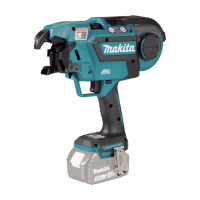19 ENGLISH
► Fig.22
Tying work
CAUTION: Before inserting the battery
cartridge, be sure to release your fingers from
the switch trigger and lock the trigger. If you
insert the battery cartridge while the switch trigger is
being pulled, it may cause an accident if the wire
tying process is accidentally carried out.
CAUTION: When you turn the power on, never
bring your limbs or face close to the binding or
rotating parts of the tool tip. Otherwise, you may be
injured.
CAUTION: When the power is turned on, never
touch the binding or rotating parts of the tool tip.
Otherwise, you may be
injured.
► Fig.23
Preparation before work
1. Make sure that the battery cartridge is removed
and the trigger is locked.
2. Insert the battery cartridge into the tool, and turn
the power on. When you turn the power on, the
wire is cut automatically.
NOTICE: Make sure that the tying mode lamp
lights up when the power is turned on. If it does
not light up, recharge the battery.
3. Release the trigger lock.
► Fig.24: 1. Trigger-lock button 2. Switch
trigger
3. Power button 4. Tying mode lamp
Single actuation mode
1. Push the arm securely against the tying point.
Push the tool vertically against the rebars, and
press the arm against the point where the rebars
cross at a 45-degree angle. ► Fig.25
2. Pull the switch trigger once.
3. The wire is fed and cut automatically.
4. The hook holds and twists the wire, then returns to
the original position after the wires have been tied.
► Fig.26
5. After tying, exercise care not to hook the arm on
the rebars and pull the tool up.
CAUTION: If the wire has clung to the binding
part of the tool tip, turn the power of the tool off.
Lock the trigger, remove the battery cartridge, and
remove the wire using tools such as nippers or
pliers.
► Fig.27
Continuous actuation mode
1. Switch the tool mode from the single actuation
mode to the continuous actuation mode using the
mode switching button.
► Fig.28: 1. Mode switching button
2. Release the trigger lock.
3. While pulling the switch trigger, push the tool
vertically against the rebars, and press the arm
against the point where the rebars cross at a 45-
degree angle.
Press the contact plate firmly
against the tying point.
The wire will be tied.
► Fig.29: 1. Contact plate
4. After tying, exercise care not to hook the arm on
the rebars and pull the tool up.
► Fig.30
Cautions on working
• If you move the arm from the tying position during
the wire tying process, the wire will get stuck on
the hook, which may lead to incorrect tying.
• Keep pressing the tool against the rebars until the
wire tying process is completed.
• Do not move to the next tying point until the
current wire tying process is completed.
• The tool tip rotating part (hook) twists the wire
during the wire tying
process. Hold the grip
firmly so that your body is not pulled by
the tool.
• Do not touch the wires during the wire tying
process.
• If you are repeating the wire tying processes in the
single actuation mode, fully
release your finger from the
switch trigger. Then, continue to operate the
switch trigger.
• If you pull the switch trigger when there is no tie
wire left, an error is displayed. Replace with a new
tie wire and restart the tool.
Tying tips
• Tilt the tool at a 45° angle to the crossed rebars,
and tie alternately as shown
in the figure.
► Fig.31
• Avoid strumous sections of rebars. ► Fig.32
• If tying strength is
insufficient, change the tying
orientation and perform tying twice so that
tying strength increases.
► Fig.33

